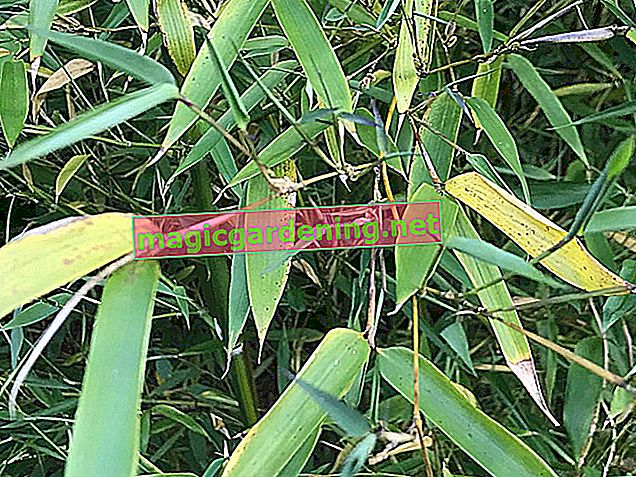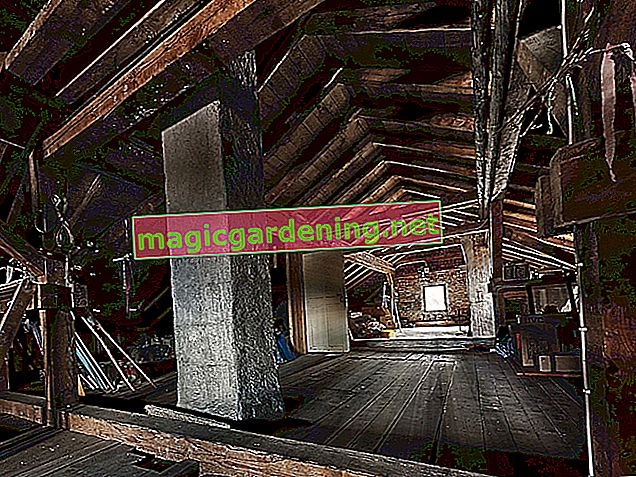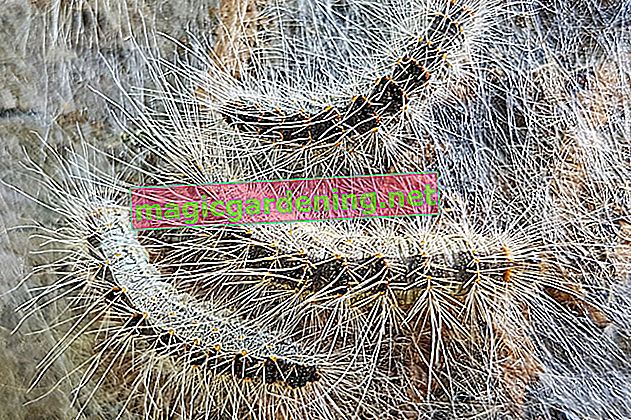
When and how do you cut? - Types of cuts and dates in brief
In the creative garden design, the privet hedge has emerged as a premium solution for representative fencing. In all sunny to shady locations with normal garden soil, the deciduous shrubs form a decorative room divider, flank the entrance gate as a green wall or make themselves useful as a privacy screen. Annual pruning guarantees that the hedge will thrive in a dense and bushy manner. If you note the following types of pruning and dates on the maintenance plan, the privet hedge will become a successful horticultural project:
also read
- Planting a privet hedge - how to plant a privet hedge
- Cutting Sequoia- How To Do It Right
- Pruning an old cherry tree - how to do it right
| Cut type | target | Appointment option I. | Appointment option II | Appointment option III |
|---|---|---|---|---|
| Plant pruning | dense branching at the base | after planting | the following spring (February) | no |
| Body section | compact growth and dense foliage | February to early March | End of June to mid-July | Mid to late August |
| Topiary | neat appearance | February to early March | End of June to mid-July | Mid to late August |
| Taper cut | Revitalize old privet hedge | November to February | no | no |
| Conservation cut bees pasture | Maintain vitality and flowering potential | February to early March | no | no |
Modern research has redefined the best time to cut a hedge. For a long time, St. John's Day (June 24th) was considered the ideal date for central pruning on deciduous and coniferous hedges. Several years of trials by the Saxon State Horticultural Institute have proven the benefits of pruning in February. Your privet hedge will grow denser and more compact when you pick up the hedge trimmer for the first time in mid to late February (€ 135.56 on Amazon *). At the end of June and the middle to the end of August , two time windows open for easy maintenance cuts that focus on this year's growth.
Plant pruning instructions - prelude to the perfect privet hedge
A privet hedge made from inexpensive, bare-root goods can be planted from October to March. The young plants usually have a strong central shoot and several, weaker side branches. A plant cut aims for better branching in the lower area. Inexperienced home gardeners have serious scruples about this radical measure, because the clippings were paid for. If you fail to cut the plants, you will struggle with a bare hedge base in the long run. How to complete a skillful cut on the day of planting:
- Stretch cords along the newly planted privet hedge as a guide
- Cut the young shrubs by half on all sides
- Trapezoidal branches intersect with a narrow crown and wider base
You should also rely on the plant pruning effect when using potted products for your new privet hedge. The pruning of the better branched young shrubs in the container can be reduced to a third of the length. The weaker the side shoots, the stronger the circumference of the cut. In this early phase of maintenance of the cut, the later important trapezoidal shape is at least hinted at. If a wide hedge base tapers towards the crown, the upper branches cannot shade the lower shoots.

background
Juice jam causes the shoots to sprout
The importance of pruning for the perfect privet hedge is based on a close connection between sap pressure and growth. In a privet, the juices with important nutrients in their luggage tend to go up. The top bud receives the greatest sap pressure so that it grows towards the light as quickly as possible. The deeper a bud is positioned, the weaker the sap pressure and the resulting growth. The law applies equally to a shrub as a whole and to each individual shoot. Cut off the top buds of the shoots after planting, the remaining buds benefit from the increased sap pressure and sprout vigorously. The more buds are removed, the stronger the budding from the remaining eyes.Cutting technique on buds perfects the plant cut
For an exemplary plant cut , we recommend clean, freshly sharpened one-hand secateurs . In this phase of pruning, manual two-hand and motorized hedge trimmers are far too big. It is up to your individual judgment whether you use bypass or anvil scissors. Correct pruning is more important for exemplary plant pruning. That is how it goes:
- Look for a pair of opposite leaves or buds on the respective shoot
- Place the scissors a few millimeters at a slight angle above the chosen cutting point
- Do not cut into the leaves or buds and do not leave a stump larger than 5 millimeters
Knowledgeable plant pruning will undoubtedly take more time than cutting down all the young shoots briskly and imprecisely. If you follow the recommended pruning technique on buds , the additional effort will result in a vital shoot on the plant base with a lasting effect, as the growth law of peak promotion teaches us. At the same time, there are no long shoot stubs above the interfaces that dry out and serve as a target for pathogenic agents.
Assembly instructions - step by step to a magnificent hedge
In the first few years, pruning a privet hedge is characterized by a gradual structure. On the way to the desired final height, the growth in height is deliberately throttled for an optimal distribution of the sap flow to all branches and buds. It is advisable to cut twice a year on weaker growing privet species. Vigorously growing common privet and its varieties benefit from being pruned three times during the build-up phase. How to raise a densely branched and richly leafed privet hedge:
- Stretch cords along the course of the hedge as an orientation for the advantageous trapezoidal shape
- Include the hedge crown, side surfaces and flanks in the cut
- Cut so that 10 centimeters remain from the previous increment
The figure below shows the step-by-step construction of a privet hedge. Undoubtedly, the recommended course of action will take years of patience. It is important to slow down the pressure of the sap every time you prune and force it into the side shoots, which are naturally neglected in uncut shrubs. By directing the flow of sap into these shrub regions, your privet hedge thrives as an opaque green wall.

Topiary cutting instructions - this is how the accurate hedge cut succeeds
When the final height is reached, the maintenance of the cut ends in a regular shape cut. The main date is in February, because at this time a cut back to any desired extent can be carried out, including the clearing of dead wood. Optionally, cut back the current growth on your privet hedge on Midsummer Day and at the end of August for an accurate appearance for the rest of the year. From the beginning of September there should be no more pruning so that privet branches mature before winter. How to do it right:
- To maintain a conical hedge shape, stretch cords or set up wooden slats
- At the beginning, cut back the hedge crown, if necessary from a stable, stable ladder
- Trim the sides and flanks of the hedge either from bottom to top or vice versa
- In February, use scissors or a saw to thin out dead wood and shoot inward
When cutting the hedge sides and flanks, choose a position that gives you a view of the uncut foliage and orientation aids. You can achieve a smooth cut without dents with electric hedge trimmers, which you guide with straight arms out of your shoulders and parallel to the surface. You trim the hedge crown with slight swiveling movements from the back. Bent arms leave a more uneven cut.

Digression
Cutting with muscle power or machine power?
With leaves 5 to 6 centimeters long, privet ranks in the lower mid-range of popular hedge shrubs in terms of foliage size. The negative effects of mechanically operated hedge trimmers, such as when cutting cherry laurel, are not to be feared on a privet hedge. Privet leaves are small enough not to get caught between the knife bars and shredded. Furthermore, the extremely flexible shoots make cutting with an automatic hedge trimmer child's play. The motorized hedge trimmer is effective, energy-saving and time-saving for cutting a large hedge that is more than 10 meters long. You can cut smaller privet hedges either by hand or with an electric hedge trimmer.Taper cut instructions - this is how the green restoration succeeds
An old, aged privet hedge won't blame you for a radical rejuvenation cut. On the contrary, a strong pruning is rewarded with vital growth of young shoots. The floral masterpiece succeeds because privet has numerous sleeping eyes. The dormant buds can rarely be seen with the naked eye and act as an iron reserve for lost plant parts. By placing a privet hedge on the cane, you activate dormant eyes and revitalize the bushes. This is how it works:
- The best time is a frost-free, overcast day in late winter between January and the end of February
- Carefully examine privet hedge for hibernating animals and postpone the appointment if necessary
- At the beginning, cut or saw off all dead shoots at the base
- Cut back the remaining branches by half to two thirds
After a rejuvenation cut, fertilize the hedge bushes with three liters of compost and 100 grams of horn shavings (€ 6.39 on Amazon *) per square meter. Just in time for the beginning of the growing season, vigorous growth sets in, which you will accompany with a multi-year build-up.
background
The Federal Nature Conservation Act has the last word when it comes to cutting
Since the late 1990s, the situation of our 248 native breeding bird species has deteriorated dramatically. Songbirds that were previously widespread, such as tree pipit or goldfinch, are directly threatened in the population. With a view to the impending “silent spring”, the Federal Nature Conservation Act stipulates strict regulations relating to pruning. A radical cut, such as sitting on the stick, tapering or thinning, is permitted from October 1st to February 28th. With the start of the breeding season on March 1st, a summer grace period sets in, which prohibits pruning of bushes and hedges until September 30th. Slight maintenance cuts are permitted, provided that it can be excluded that nesting birds will be disturbed by the measures. Anyone who does not adhere to it must expect a heavy fine of up to 50,000 euros.Seldom cut privet hedge as a bee pasture
Privet bushes are not limited to life as a strictly formal hedge. Its pretty, white panicles of flowers are a popular destination for bees and bumblebees in early summer . In general, the dense, flexible branches are very busy, as breeding birds prefer to build their nests in privet. When fertilized flowers turn into black berries in autumn, the feathery inhabitants have a valuable source of food right in front of their beak. The privet hedge only fulfills its task as an ecological gem if the gardener practices cautious pruning.
A privet bush blooms on its annual shoots in June and July. The best time for a maintenance cut is in February. The pruning care extends to the thinning of dead or unfavorably standing shoots. A vigorous pruning could destroy a large part of the buds already established. The following overview summarizes the most important framework conditions for cutting a privet hedge as a bee pasture:
- Planting cut in half initiates dense branching
- Ideally, build up each hedge bush with 7 to 12 ground shoots as a framework
- Remove the remaining ground shoots at the base
- Thinning out a free-growing privet hedge every 3 to 5 years
- Branches that are too long or heavily branched lead to a young side shoot in the lower branch area
- If necessary, cut back lanky long shoots by a third in June or August
- Cut off branches that are inclined to the ground and have roots there
Ground shoots of a privet bush remain vital and willing to bloom for 5 to 8 years. Make a note of a cut on the maintenance regimen every few years and allow natural growth to take place. It is advantageous if you combine a maintenance pruning with the exchange of 2 to 3 of the oldest scaffold shoots for young ground shoots. In this way, you subject a freely growing privet hedge to a continuous rejuvenation, which saves you having to go radically on the stick.

frequently asked Questions
Are Privet Bushes Poisonous?
The Federal Ministry for the Environment and Nature Conservation regularly publishes an official list of poisonous plants in the Federal Gazette. All plants are listed which can lead to moderate to severe poisoning after contact. Privet is not on this list. Nonetheless, eating berries and can cause nausea and vomiting. Sensitive gardeners sometimes complain of itchy eczema, known as privet eczema, when they come into contact with the sap. Regular topiary cuts prevent a privet hedge from blooming and fruiting. So there is nothing against cultivation in the family garden. If you wear gloves and long-sleeved clothing when cutting, contact with the slightly toxic juice is prevented.
I want to plant a privet hedge as a privacy screen. How big should the distance to the neighboring property be?
The first question to be answered is how high the hedge should ultimately be. A privet hedge with a height of 200 centimeters in the recommended trapezoidal shape offers reliable privacy protection. A width of 80 to 100 centimeters must therefore be taken into account in the lower area. If your neighbor allows the hedge to be cut from his property, the legally compliant distance is 50 to 60 centimeters (more or less depending on the state). If you are forced to cut the side of the hedge facing the neighboring property from your garden, there is a further 80 to 100 centimeters of space so that you can maneuver the hedge trimmer unhindered.
What does “bare-root goods” mean when buying privet for hedge planting?
Trees with bare roots do not have a firm ball of earth. Tree nurseries offer the trees at the same time as the best planting time, from the beginning of October to the end of April. Due to the low weight and uncomplicated processing, bare-root privet can be offered more cheaply than potted or container plants. In contrast to trees with balls of earth, you cannot store bare-root goods for a long time. In addition, pruning is urgently recommended in order to compensate for the loss of root mass due to clearing.
In the garden center, I learned that oval-leaved privet cannot stand severe frost. My garden is in a winter gray region with up to 2-digit minus degrees. Do I have to do without a privet hedge now?
If the thermometer falls well below - 10 degrees Celsius in winter, Ligustrum ovalifolium loses its leaves and most of the shoots freeze back. Although the shrubs do not die off completely, they lose their beauty noticeably. It is better to use the frost-hardy variety 'Atrovirens' for the privet hedge. The native wild species was the inspiration here and guarantees reliable winter hardiness without compromises. In the 2-digit minus range, the leaves fall off. Just in time for the beginning of spring, fresh leaves sprout on the undamaged shoots.
There is an 8-year-old privet hedge in our garden in the Rhineland. Every year we ask ourselves when the hedge should be cut at the latest. A stronger pruning must be completed by the end of February due to the start of the breeding season. Does it damage our privet hedge if it freezes heavily again in March or April?
It does no harm to a privet hedge if it is exposed to more severe frost after pruning in February. This applies primarily to common privet (Ligustrum vulgare) and the varieties derived from it. Oval-leaved privet is a bit more sensitive to frost, but can withstand a cut in February without damage. In the Rhineland, the thermometer in March and April does not usually fall so low that frost damage could occur.
The 3 most common mistakes
A privet hedge that is much too loose and balding at the base and inside is the result of incorrect pruning. The following table presents the 3 most common cutting errors with tips for effective prevention:
| Cutting errors | Damage | prevention |
|---|---|---|
| no plant pruning carried out | sparse branching at the hedge base | Cut back all shoots by half after planting |
| rectangular hedge shape | bald hedge from below and inside | Cut privet hedge in a conical shape |
| Growing privet hedge too quickly | loose branching, little privacy | step-by-step construction in 10 cm steps |
Tips
A young privet hedge does not yet fulfill its privacy protection function. To protect you from prying eyes during the transition period, you should install reed mats or a fence. You can build a privacy fence made of wood yourself with a little manual skill. Alternatively, set up a chain link fence (€ 119.00 at Amazon *) and plant annual climbing plants until your privet hedge has reached the desired final height.








